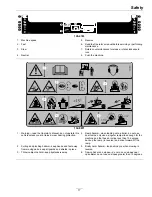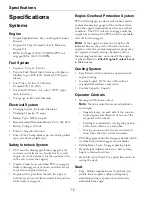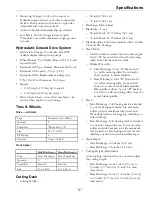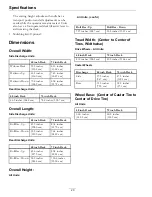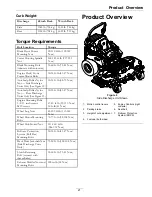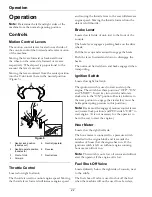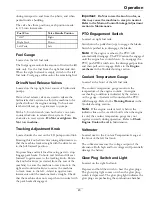
Operation
Low Oil Pressure Light
Located on the right fuel tank.
Light will come on when engine oil pressure is low
or lost.
Warning Buzzer
Located behind the seat under the air deflector on
the electrical panel.
The buzzer is a warning signal that the engine
is overheating or the oil pressure is low. See the
Troubleshooting section.
Note:
If the engine coolant level is below the
indicator line on the overflow bottle when the engine
is cold, the warning buzzer may not sound if the
engine overheats. Refer to
Check Engine Coolant
Level
in Maintenance.
Deck Lift Pedal
Located at the right front corner of the floor pan.
Push the pedal forward with your foot to raise the
cutting deck. Allow the pedal to move rearward to
lower the cutting deck to the cut height that has been
set.
Pre-Start
Fill fuel tank on level ground.
Make sure you understand the controls, their
locations, their functions, and their safety
requirements.
Refer to the Maintenance section and perform all the
necessary inspection and maintenance steps.
Determining Fuel
The engine runs on clean, fresh diesel fuel with
a minimum octane rating of 40. Purchase fuel in
quantities that can be used within 30 days to ensure
fuel freshness.
Use summer grade diesel fuel (No. 2-D) at
temperatures above 20°F (-7°C) and winter grade
diesel fuel (No. 1-D or No. 1-D/2-D blend) below
20° F (-7° C). Use of winter grade diesel fuel at lower
temperatures provides lower flash point and pour
point characteristics, therefore easing startability and
lessening chances of chemical separation of the fuel
due to lower temperatures (wax appearance, which
may plug filters).
Use of summer grade diesel fuel above 20°F (-7°C)
will contribute toward longer life of the pump
components.
Important:
Do Not use kerosene or gasoline
instead of diesel fuel. Failure to observe this
caution will damage the engine.
Do Not
overfill fuel tank. Fill the fuel tank to the
bottom of the filler neck. The empty space in the
tank allows the fuel to expand. Overfilling may result
in fuel leakage or damage to the engine or emission
system.
If possible, fill the fuel tank after each use. This will
minimize possible buildup of condensation inside the
fuel tank.
Biodiesel Ready
This machine can also use a biodiesel blended fuel
of up to B20 (20% biodiesel, 80% petrodiesel). The
petrodiesel portion should be low or ultra low sulfur.
Observe the following precautions:
•
The biodiesel portion of the fuel meets
specification ASTM D6751 or EN14214.
•
The blended fuel composition should meet
ASTM D975 or EN590.
•
Painted surfaces may be damaged by biodiesel
blends.
•
Use B5 (biodiesel content of 5%) or lesser blend
in cold weather.
•
Monitor seals, hoses, gaskets in contact with fuel
as they may degrade over time.
•
Fuel filter plugging maybe expected for a time
after converting to biodiesel blends.
•
Contact your distributor if you wish for more
information on biodiesel.
Operating Instructions
Raise the Rollover Protection System
(ROPS)
Important:
The roll bar is an integral and
effective safety device. Keep the roll bar in the
raised and locked position when operating the
24








